Centennial Park’s Director Joseph Maiden first planted a Rosarium on the site of the current Rose Garden in 1909, and subsequent plantings have been popular with visitors to the Park ever since.
This blog explores the rich history of the Rose Garden and how at one point, it was the most visited rose garden in Australia.
The beginning of the Rosarium
The shrubberies and formal flower gardens form the principle elements of the flowering of Centennial Park when directed under Joseph Maiden, who generally classified his work into two structural types; area of permanent nature (eg shrubberies), and areas of an essentially ephemeral or seasonal nature (eg flower beds).
Unlike much of the avenues, and Melaleuca groves you see in the Park today, most of the shrubberies and flower gardens embroidered existing spaces where they added a complexity and detail to the simple and broad parklands established by Charles Moore.
One of Maiden’s main influences on the design and aesthetics of Centennial Park is the strategically placed featured and ornamental plantings and garden beds around the northern shores of the main lakes, and along the central zone roadways – today you know them as Rose Garden and Column Garden.
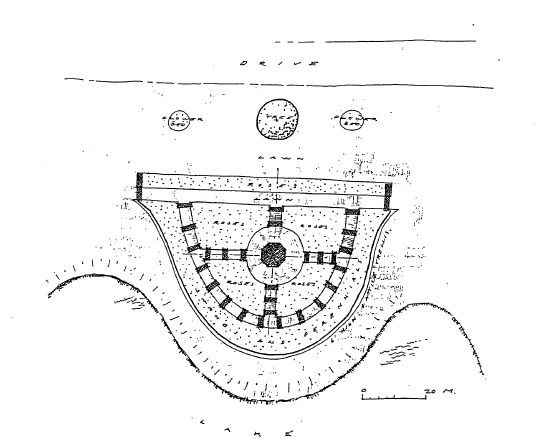 Plan of Rosarium c1912
Plan of Rosarium c1912
By the end of 19th century the northern edges of Busby’s Bore Pond became the principal site in the park for intensive ornamental horticulture, where Maiden established the Native Flower Plantation Rosarium and New Flower Garden. In 1909, Maiden notes that:
On the middle of the three tongues of land that project into Busby’s Bore pond a beginning has been made with a new Rosarium. A portion of the main encircling border has been planted.
Extensive preparation of the ground was necessary, the sand being ‘entirely removed to a depth of two and half feet, and replaced with good still soil and manure’. Apart from the complete unsuitability of the natural ground (pure sand), the location was regarded by Maiden as ‘very well situated’, ‘jutting out into the No.5 dam in the centre of the Park next to the native flower plantation’. Three hundred roses were planted in the ‘encircling border’.
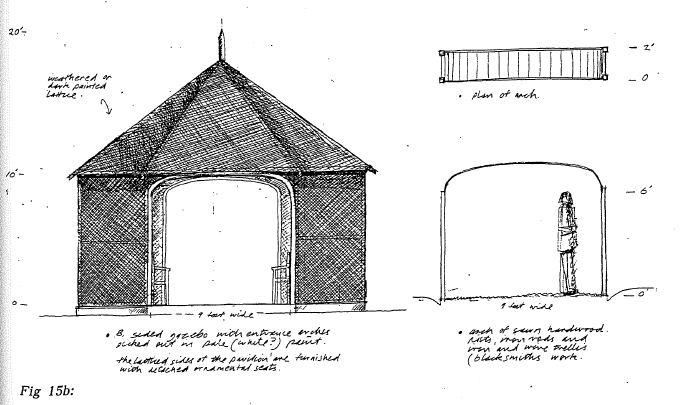 Details of latticed gazebo and arbour c1912
Details of latticed gazebo and arbour c1912
New structures
By 1910, a handsome and extensive lattice trellis had been constructed on the outside of this border to enclose the pond edge perimeter. The size of this structure was enormous. A photograph of 1912 shows it be about six to eight feet high and it was reported to be ‘310 feet long, with ‘2,320 feet of hardwood timber and 20,000 feet of lattice used’. The purpose of the trellis was clearly decorative, and Maiden’s description of it gives further insight into his horticultural philosophies:
The design we have adopted is what we considered the best form, crossed lattice, Trellis work is inexpensive and a very effective means of adding to the beauty of a garden, as a weeper-clad fence is a good feature, and serves to show the many beautiful climbing roses which are a delight to look upon.
The long lattice screen also served the dual purpose of wind barrier, whereas on the adjoining promontories where the other two gardens were developed, the fierce southerly winds often blew the soil completely away from newly planted shrubs.
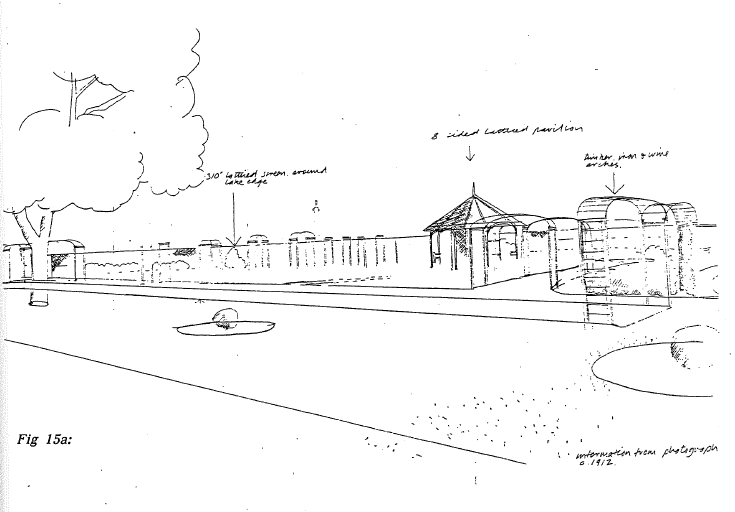 Sketch of Rose Garden c1912
Sketch of Rose Garden c1912
Some impression of the extent of the Rose Garden by 1911 can be gained where it was reported ‘to be fully out’ and planted with ‘1,700 rose trees (sic)’ (i.e. 500 in addition to the 1,200 planted in 1910). A structure of some kind was central to any rose garden of that period that had pretensions to public importance. Accordingly, this was to be a ‘pergola’ (in fact what we would now call a summer house with arbours about it).
In 1911, the pergola was being constructed by the Park’s own carpenter and blacksmith and it was hoped that ‘when erected with its supporting arches and festoon work (it) will make the rose garden a most attractive feature’. By 1912, the new Rose Garden had been completed.
…with the planting of 600 additional rose trees (sic) and completion of the pergola which consists of a centre pavilion 20 x 20 x 20 high, octagon shape. The frame is built of hardwood, strongly braced with iron, with four entrances 9’ wide, the remainder covered with trellis work. The (interior) sides of the pavilion are 18 iron arches with connecting links on wooden posts. There are also 18 arches 9’ wide placed round the sidewalks. The arches and pavilion are planted with strong growing climbing Roses.
20,000 visitors
The ‘Rosery’ by 1915 had become the most popular horticultural feature of Centennial Park, and Maiden notes:
This has again been a great source of attraction, and we are very proud of it. Many people from distant states and New Zealand called to express their surprise and pleasure at seeing such a display.
In addition, a number of standard and pillar roses were introduced to the garden during the year. A significant modification was carried out in 1916 in this area by the introduction of ‘six long beds of pleasing design outside the trellis’. These beds were planted en masse with named varieties of shrub rose, ‘also several weeping standards to show what may be done in way of grouping and edging’. This demonstrative and educational theme) here shown in horticultural displays) became a characteristic of Maiden’s style of park management.
It was also reported that roses were sought after by thieves, so much so, the Park’s third overseer, James Dawes, confessed with amazement that in 1916 that ‘within the space of two weeks, one bed of roses, comprising of 90 varieties was completely cleared. This problem was not unique to Centennial Park, but it was compounded by the Park’s size and the initial difficulties of establishing plants.
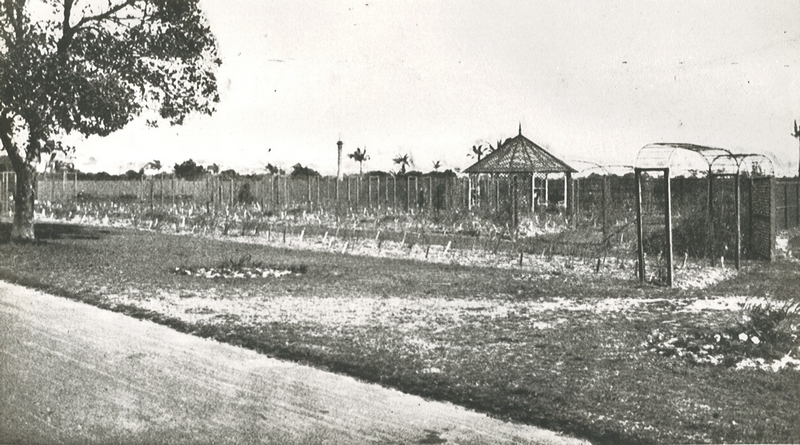 Image courtesy of the State Library of NSW - Rose Garden, Centennial Park 1914
Image courtesy of the State Library of NSW - Rose Garden, Centennial Park 1914
By 1917, the Rosery represented every mode of culture, viz. bush, standard, arches, walls, hedges and (we think a new idea) dwarf training to represent carpet bedding’. This style received much interest and was much admired by visitors. This effect was also achieved ‘by planting a design of beds with climbing roses (Polyantha varieties, planted in 1915), then training them to a low trellis 15” from the ground’, to represent a carpet’.
The popularity and success of the Rosery may be attested by Maiden’s observation that ‘visitors from other states say that it is the greatest of its kind to Australia. Moreover in 1917 when people came to see the roses in flower, ‘the police and watchmen estimated that on Sunday along there were upwards of 20,000 visitors.’
Near to the end of the first nine years of the Rose Garden, considerable remodelling of the planting had to be done. From 1917 to the end of Maiden’s directorship (1923) the combined problems of rose culture, sandy soil and seasonal water-logging caused the death of many plants. The abnormally wet season of 1917 caused the adjoining pond to be overfull the part of the year and thus water logged the outer border and other low-lying beds.
Some of these problems were overcome by raising the affected beds and by laying drains. However, these loses gave the opportunity to incorporate new ideas, and to improve the design.
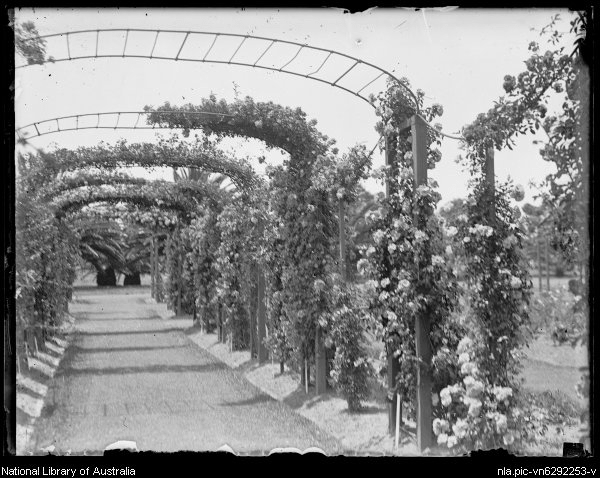 Image courtesy of National Library of Australia - Flowering arched avenue in Centennial Park, 21 July 1929
Image courtesy of National Library of Australia - Flowering arched avenue in Centennial Park, 21 July 1929
In 1918, upwards of 2,000 new plants were put in clumps of 18 of one variety in order to get a better colour effect by making distinct colours. More replanting was required in 1919, but by 1921 Maiden notes that the Rose Garden would take a year or so to put in order.
In Maiden’s final year of responsibility for Centennial Park (1923), 'the Rose Gardens appear to have been a great success, much work having been carried out during the year, including many improvements, ‘rearranging the beds and borders, making one variety in each bed’.
As in previous years many people came from all parts to see it. ‘The climbers were fine as all the trellis work was covered with good wood and flowers’.
The re-arrangement of the rose beds in 1918 and again in 1923 suggests that during Maiden’s term of office the rose began as generally mixed varieties in beds, and clearly ended up the more typical (today), single varieties in each bed.
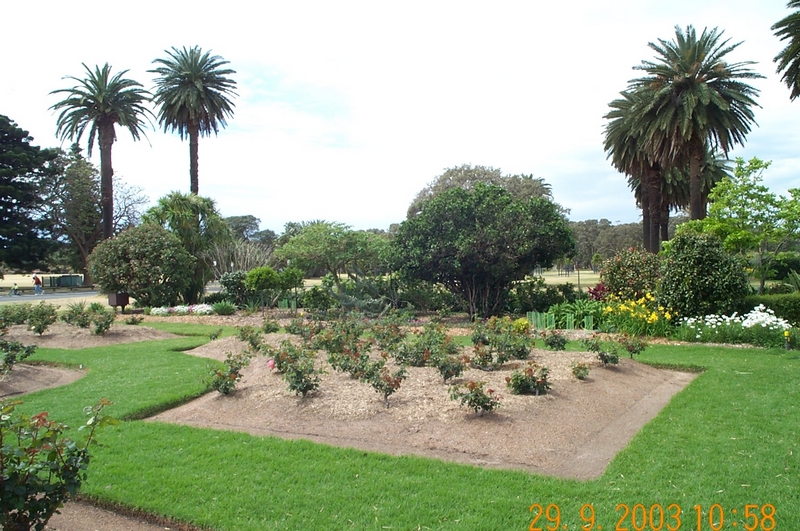 Rose Garden, Centennial Park, 29 September 2003
Rose Garden, Centennial Park, 29 September 2003
Come and see the roses in bloom
The Rose Garden was renovated in 2003 and again recently in 2018, with many new varieties added including Betty Cuthbert, Home and Garden and Blueberry Hill as well as existing varieties: Double Delight, Pope John Paul II, Merry Maker, Just Joey and Queen Elizabeth.
Today it has hundreds of gorgeous roses making it a popular spot for visitors, weddings and picnics. The Rose Garden is located adjacent to Busby’s Pond and is now in full bloom. Make a day of it and come spend the day in the Park.
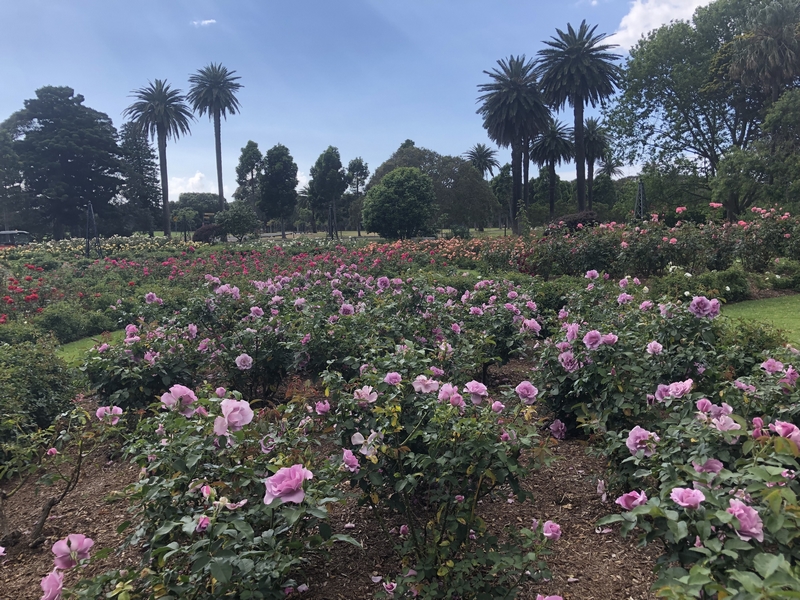 Centennial Park Rose Garden, November 2019
Centennial Park Rose Garden, November 2019
Share your roses experience with us by tagging us on Instagram or Twitter @CentParklands #CentennialParklands.